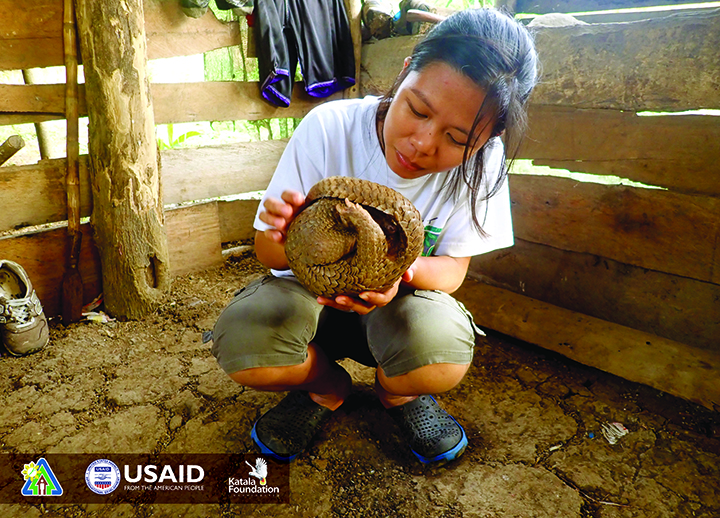Moved by the uncertainty of the Palawan pangolins’ future, three young research assistants — Shiela, Elvie and JR — from the Katala Foundation Inc., have been braving the wilderness of Southern Palawan for months in search of the elusive pangolins. Jonathan L Mayunga writes about the researchers’ mission…
Carrying nothing but backpack loaded with extra shirts, a towel, water, food, a notebook, pen and the all-important global-positioning satellite device and a satellite phone, plus camera traps, they trek unfamiliar terrains, climb trees, crawl under thick shrubs and tall grasses, cross rivers and streams, night or day, looking for signs—scratch mark, tracks or footprints, even feces left behind by the little-known scaly anteater or pangolin (Manis culionensis de Elera) that can only be found in Palawan.

The project was commissioned by the USAID-funded Protect Wildlife Project.
The Philippines, an archipelago comprising of 7,641 islands and islets, is one of the megadiverse countries in the world. However, it is also one of the so-called biodiversity hot spots because of the rapid rate of biodiversity loss.
Experts say because of biodiversity loss that’s aggravated by illegal wildlife trade, highly vulnerable endemic species the Philippines is known for may have become extinct even before their discovery.
Previously thought to be the Malayan or Sunda pangolin (M. javanica), the Palawan pangolin remains a mystery even to the indigenous people of Palawan, considered the country’s last ecological frontier. While there is no empirical data that would suggest the accuracy of their claim, as far as the upland communities are concerned, the Palawan pangolins are vanishing.
Commissioned to do research on the Palawan pangolins by the Protect Wildlife Project that is funded by United States Agency for International Development (USAID) in Southern Palawan, conservation efforts are focused on the Palawan pangolins because of the threat of illegal wildlife trade, with the hope of saving the critically endangered species before it becomes extinct.

The Katala Foundation Inc. is expected to complete the research and come up with policy recommendation to save the vanishing Palawan pangolin by the end of the year.
Mysterious mammal
In funding the “Study on the Indicative Presence and Abundance of the Palawan Pangolin in Southern-Central Palawan,” Protect Wildlife Project Communications Manager Lawrence San Diego said the Palawan pangolin is the only pangolin species endemic to a single country.
“The Philippine pangolin is a priority species for conservation of the Protect Wildlife Project,” he said.
This is because the Palawan pangolin is one of the least studied species of pangolin and there is very little scientific information available to properly manage its remaining population.
The study aims to determine the mammal’s rate of exploitation and abundance in the wild to come up with policy recommendation and plan of action that will help protect and conserve this vanishing species.
So far, the study is focused on Victoria-Anepahan Mountain Range, which has a total land area of 510,520.66 hectares. The Victoria-Anepahan Mountain Range straddles Puerto Princesa City, Aborlan, Narra and Quezon towns. The area has been identified as an important habitat for biodiversity and endemic Palawan species, such as the pangolin.
The Palawan Council for Sustainable Development (PCSD) and the Palawan State University are also embarking on research to know more about the diet of the Palawan pangolin, to aid in managing its population and, hopefully, come up with ways to boost its population on the island.
Nelson Devanadera, PCSD executive director, said samples of pangolin’s feces will also be sent to Australia for laboratory testing.
He said knowing the diet and nutrients of the pangolin’s—basically, ants and termites—will help explain why it is now the most sought-after animal because of the belief that its meat and scale have medicinal value, hence, is now being hunted to extinction.
More important, he said, knowing what plant species the ants and termites eat, must be identified in order to protect and conserve them from various threats, and if possible, propagate them in other areas, to help protect and conserve the pangolin.
In the meantime, he said PCSD is working closely with various law-enforcement agencies to prevent illegal wildlife trade, not only of pangolin but other threatened species of Palawan.
What locals know
While very little is known about the species, the Palawan State University has held interviews and focus group discussions with upland communities to gather information on sightings and presence of pangolins in their areas, its traditional uses and hunting techniques; and known practices on its collection and trade.
According to local communities, poaching and illegal trade of pangolin meat and scales persist. The meat can fetch for $3 to $5 a kilogram, while the scales can be sold for $130 to $190 a kilo.
While communities are aware that hunting and trade of pangolins are illegal, they continue to persist.
Meanwhile, the field research team from Katala Foundation had so far conducted ground surveys in 12 200-hectare plots in the wilderness of the Victoria-Anepahan Mountain Range, entailing actual search, recording and measurement of pangolins in the wild and observing their forest habitats.
Initial results of the study revealed that from September to December 2018, the team recorded 14 pangolins—two of which are pregnant—in a total surveyed area of 800 hectares.
The ground surveys showed that slash-and-burn farming, charcoal making and timber poaching continue in forest habitats where the pangolins are recorded.
‘Most illegally traded animal’
According to the Environmental Investigation Agency (EIA), pangolins are the most illegally traded animal in the world.
Hunted for their meat and scales for use in traditional medicine, these shy nocturnal mammals may become extinct faster than elephants, tigers, rhinos and other iconic animals, whether in Africa or Asia.
There are eight known species of pangolins, four are found in Africa and four in Asia.
All pangolin species were listed in Convention on International Trade in Endangered Species (Cites) of Wild Fauna and Flora Appendix I in 2016. The inclusion in Appendix I means the pangolins—all eight species including the Palawan pangolin—are threatened with extinction.
Under Cites Appendix I, the trade in specimens of these species are permitted only in exceptional circumstances.
According to EIA as many as 1 million pangolins have been illegally traded within Asia in the past 10 to 15 years.
Organized crime
In the Philippines, the Palawan pangolin is also the most illegally traded animal and the perpetrators are well organized. Anti-illegal wildlife trade operatives believe that organized crime syndicates are behind the lucrative pangolin trade and are in cahoots with local communities.
Just last month, authorities arrested two fishermen and a van driver for transporting 10 live pangolins in Barangay Mendez Crossing East, Tagaytay City.
Arrested were Simfroso Cauntay Salazar, 53, driver and a resident of Kilometer 115 Talisay, Calatagan, Batangas; Jorlan Libertino Torrequinada, 39, and Victor Cabuniag Equiza, 40, of P. Mabuhay Abaroan, Roxas, Palawan.
Rogelio Demelletes, a senior management specialist and one of the anti-illegal wildlife trade operatives of the Philippine Operations Group on Ivory and Illegal Wildlife (Task Force Pogi) of the Department of Environment and Natural Resources (DENR) said the fact that two of the suspects are from Roxas town is proof that locals are in cahoots with the members of the syndicate.
Deeper investigation
The Task Force Pogi said the investigation on the illegal pangolin trade is without letup.
“We are still conducting a follow-up investigation. What we want is to identify the buyers and catch them,” Demelletes said.
As for the arrested suspects from Tagaytay City, Demelletes said authorities have so far initiated inquest proceedings but cases have yet to be filed.
Asked what will be the next step for the DENR Task Force Pogi and its partner-law-enforcement agencies, he said: “We need to cut down at least one of the participants in the trade cycle.”
Ricardo Calderon, the DENR’s assistant secretary for Staff Bureau and concurrent Director of the Biodiversity Management Bureau (BMB), underscored the importance of combatting the illegal trade on pangolin in Palawan.
He said the DENR continues to strengthen the capacity of law-enforcement agencies, including its own, and is coordinating with concerned government agencies and institutions to stop illegal wildlife trade, with particular focus on the Palawan pangolin.
“We are strengthening our wildlife enforcement in our seaport. In Palawan, we are coordinating with PCSD as they have jurisdiction over Palawan as per Wildlife Act. Wildlife trafficking is now a transnational crime and we have law-enforcement coordination at the regional level among 10 Asean member-states,” he said.
Pangolins are very vulnerable. While they appear to be a sturdy species, these nocturnal, very shy mammals, are sure to die in captivity.
Demelletes said three of the 10 recovered pangolins have already died because of stress.
“In the next few days, the remaining seven may also die because pangolins are hard to feed. But because they are evidence in court, we cannot just return them to Palawan,” he lamented.
As authorities step up the various initiatives to know more about the little-known species, they are also racing against time to prevent the illegal wildlife trade to prevent their extinction.
Leave a Reply
You must be logged in to post a comment.